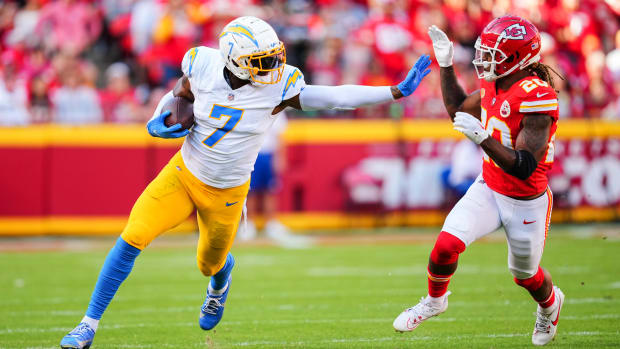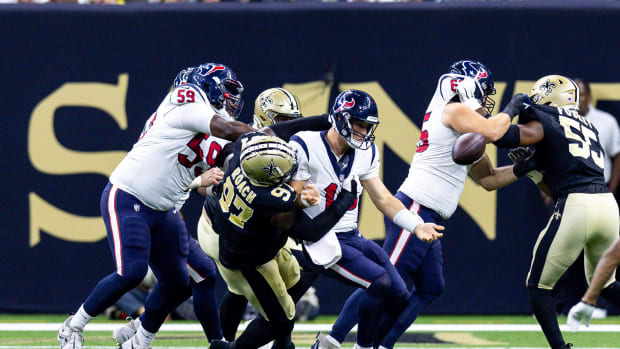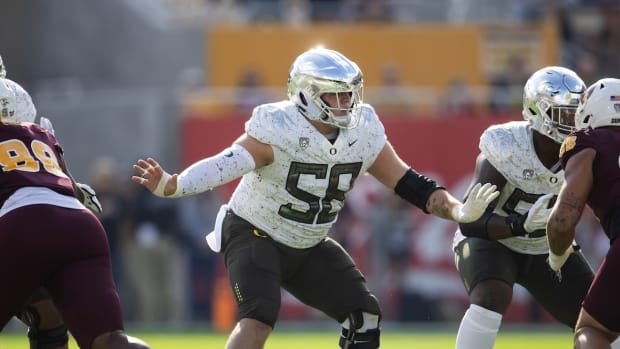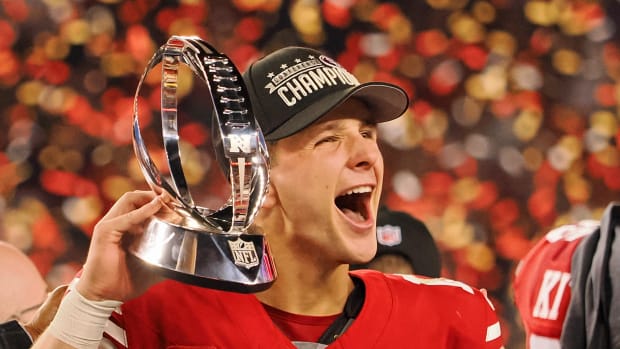
The Elite Will Rise
Colin Kaepernick and Frank Gore are two of the 49ers wild-card-round high eight purple-chip players. (Tom Hauck/AP)
Here comes the NFL postseason. Time for the script to be flipped.
Every year we see it. "This team" or "these teams" are going to the Super Bowl. Look how good they were during the regular season. Totally dominated.
Yet that rarely happens. Only twice in 11 years (22 different chances) have the top seed in either conference won the Super Bowl. It hasn’t even been easy to win a playoff game: top seeds are only 7-9 in the divisional round after the bye. The past three seasons, No. 1 seeds have gone 2-5 in the divisional round—the Falcons barely escaped, 30-28, against the Seahawks; and the Patriots pasted Tim Tebow and his Broncos 45-10, in the last game Tebow ever started at quarterback.
Why is success in the postseason so fickle for the strongest regular-season teams?
You’ll hear many theories: that teams coming off the bye are rusty; that while offense wins in the regular season, defense wins in the postseason; that top seeds had easier schedules while lower seeds are more battle tested; that the winning team had better matchups.
Probably a little bit of all of that is true. For me, postseason games come down to one thing: how many elite or near-elite level players—a blend of blue- and red-chip players we’ll refer to as "purple" chip players—each team has, and how many of them play at that level on game day. Having good depth and coaxing solid performances out of emergency fill-ins is helpful against the also-rans during the regular season, but at some point the best players have to make a difference.
Take last year, when the Ravens upset the Broncos 38-35 in overtime, as an example..
Going into the game, the Broncos had—and this is obviously subjective—seven purple chips: QB Peyton Manning, WR Demaryius Thomas, LT Ryan Clady, LG Zane Beadles, DE Elvis Dumervil, LB Von Villmer and CB Champ Bailey. The Ravens had eight: QB Joe Flacco, RB Ray Rice, TE Dennis Pitta, RG Marshall Yanda, WR Anquan Boldin, DT Haloti Ngata, OLB Terrell Suggs, FS Ed Reed.
As far as performance, you could make the argument that only Beadles and Miller played well for Denver, relative to their level. For the Ravens, it was Suggs, Flacco, Pitta and Boldin.
The Ravens had more top players, and they played better. That equals a victory, or a darn good shot at one.
So when the games start this weekend, I’ll be looking at the purple chips on each team to see whether they are measuring up under pressure. Here's how those top players break down:
Chiefs vs. Colts
More Playoffs
Peter King looks at each of this weekend's wild-card games, and picks his winners. FULL STORY
Andy Benoit goes beyond the obvious storylines to study the matchups in this weekend's games. FULL STORY
Meanwhile, our writers make their complete playoff predictions, including the Super Bowl winner and MVP. FULL STORY
Chiefs (6):
RB Jamaal Charles, NT Dontari Poe, OLB Justin Houston, ILB Derrick Johnson, OLB Tamba Hali, S Eric Berry
Colts (5): QB Andrew Luck, OLB Robert Mathis, CB Vontae Davis, DT Cory Redding, WR T.Y. Hilton.
How things are trending: There’s no question the Chiefs have a better roster than the Colts, who were hit hard by injuries on the offensive side the ball by losing WR Reggie Wayne and TE Dwayne Allen. The problem is, the Chiefs’ defense—the backbone of the team—has completely fallen off in the second half of the season. Unless they find a way to start executing better, the Chiefs are going to have a hard time winning this game. The Colts have been trending the other way. Offensively they’ve figured out how to play without Wayne, and defensively they are getting healthy and executing.
Saints at Eagles
Saints (5): QB Drew Brees, TE Jimmy Graham, DE Cameron Jordan, OT Zach Strief, third-down back Darren Sproles.
Eagles (6): RB LeSean McCoy, LG Evan Mathis, LT Jason Peters, WR DeSean Jackson, OLB Trent Cole, C Jason Kelce.
How things are trending: You can make a very convincing argument that no team is executing better on either side of the ball better than the Eagles. And execution overcomes talent you may lack, which the Eagles do on defense. The Saints play well at home, and terribly on the road. If they don’t figure out how to solve that, the Saints will lose in Philadelphia.
Chargers at Bengals
Chargers (5): QB Philip Rivers, TE Antonio Gates, S Eric Weddle, OT King Dunlap, third-down RB Danny Woodhead.
Bengals (6): WR A.J. Green, OT Andrew Whitworth, DE Michael Johnson, LB Vontaze Burfict, OT Andre Smith, third-down back Giovanni Bernard.
How things are trending: No team exemplifies the talent/execution conundrum more than the Bengals, who despite a good roster have lost playoff games the last two years because of poor performances. Two years ago, the Texans were more talented and won big. Last year, a rematch was there for the Bengals to win, but they couldn’t do anything on offense. This one again is about the offense, and QB Andy Dalton. Cincinnati has a decided mismatch on offense against the San Diego defense. But if the Bengals don’t play well on that side of the ball, the Chargers will win.
49ers at Packers
49ers (8): LT Joe Staley, OLB Aldon Smith, ILB NaVorro Bowman, ILB Patrick Willis, DE Justin Smith, RB Frank Gore, WR Anquan Boldin, S Eric Reid.
Packers (6): QB Aaron Rodgers, LG Josh Sitton, WR Jordy Nelson, RB Eddie Lacy, WR Randall Cobb, DE Mike Daniels.
How things are trending: With the Packers’ usual injury problems, the 49ers enter this game with a distinct advantage in terms of talent—and I didn’t even include WR Michael Crabtree, who is elite when healthy but not quite there. He’s still extremely valuable to the offense. The 49ers should win this game if their best players play well, but the big question is how will they execute in the brutal cold at Lambeau Field.
Pressure Points
This season at The MMQB, we wanted to look at measuring the pass rush differently. And NFL coach will tell you sacks, no matter whether they’re used defensively or against an offense, are an extremely poor measure of pass rush. For individuals, a player can often get sacks because of great coverage in the secondary, or because another player forced the quarterback to the sacker. And, really, the name of the game is affecting the quarterback: making him uncomfortable by forcing him to throw either from off his spot, or before he’s ready to pass. So we decided, with the help of our friends at ProFootballFocus.com, to compile an all-encompassing pressure statistic that evaluated the different sacks, awarded sack assists, and gave credit for drawn holds, hurries and hits. So Pressure Points was born, and to truly measure the effectiveness of individual and team pass rushers, we divided them by snaps.
Now that season has finished, we're ready to crown the champions.
The MMQB Edge Rusher of 2013
Robert Quinn, St. Louis Rams
This was a little bit of an upset because, for much of the season, Quinn trailed Ravens outside linebacker Elvis Dumervil despite ultimately outsacking him 19 to 9.5. The reason? Dumervil accumulated a ton of pressures and rushed the passer 183 fewer times than Quinn. But Quinn finished with a flourish, while the Ravens’ pass rush fell off in the final three games against the excellent offensive lines of the Lions, Patriots and Bengals.
Quinn may have lost the sack race to Robert Mathis of the Colts (19.5), but there’s little question Quinn was the more productive pass rusher overall. Quinn drew one more hold, had 14 more hurries and nine more QB hits.
“What can you say about Rob?” coach Jeff Fisher said after Quinn was carried off the field by his teammates after he set the franchise record of 18 sacks against Tampa Bay. “Very impressive when you take into consideration the history of the organization—and the defensive linemen, the pass rushers, and the Fearsome Foursome, all of that stuff. For him to set the single-season franchise sack record was pretty impressive.”
The MMQB Unsung Edge Rusher of 2013
Elvis Dumervil, Baltimore Ravens
You’ll have to go a ways down the list of sack leaders, all the way past teammate Terrell Suggs (10 sacks), to find Dumervil’s name tied for 25th with 9.5. And he’s only 12th if you just look at total Pressure Points.
But because Dumervil was in his first season at outside linebacker for Baltimore, after spending most of his career at end with the Broncos, and had to drop into pass coverage at times, he rushed the passer on a part-time basis with 183 fewer snaps than Quinn. But no one besides Quinn did more with his snaps than Dumervil with 67 total disruptions. Not bad for a guy who was a late throw-in after his renegotiated contract with the Broncos was faxed late, causing him to become a free agent.
“Definitely the addition of a guy like Dumervil who has replaced the edge rushers that they’ve had there, whether it be [Paul] Kruger or Jarret Johnson from years past, he’s certainly given them another good player to play opposite of Suggs,” Patriots coach Bill Belichick said. “[Courtney] Upshaw and [Pernell] McPhee have done a good job for them in there too. But I’d say that adding Dumervil to that group that they had, that’s been a big addition for them.”
The MMQB Interior Rusher of 2013
J.J. Watt, Houston Texans
This has been in the bag for nearly the entire season, although Buccaneers’ tackle Gerald McCoy made a valiant late-season run and might have caught Watt if Tampa’s since-fired staff put him in a better position earlier in the season.
What can you say about Watt? Despite being on a team that lost its last 14 games, he never stopped being dominant. No player, regardless of position, hit the quarterback more (37), and only Greg Hardy of Carolina caused more sacks for other teammates (5.5 sack assists). He won’t get the award because of the team that he played on, but Watt was the best defensive player in the NFL again this season.
“J.J.'s probably the top defensive lineman in the league, I think everybody can see that from the way he plays," Texans defensive coordinator Wade Phillips said last month. "I don't know about all the numbers. He's really hit the quarterback a lot of times. Hasn't had as many sacks, but he's got a lot of hits on the quarterback. He's still getting a lot of tackles for loss. He knocked down a ball again last game. He's consistently a great player every game."
The MMQB Unsung Interior Rusher of 2013
Malik Jackson, Denver Broncos
When Jackson first surfaced in our rankings in Week 4, when he was the unsung rusher, I had no idea who he was or what he had done. And, honestly, I figured he would quickly fade from the rankings as the games and snaps accumulated. But there he stayed for the entire season, finishing tied for third with Bills tackle Kyle Williams despite posting just six total sacks. But with 45 additional pressures in 385 snaps as a situational pass rushing, Jackson was consistently productive. In every game, he showed up in the Broncos’ pass rush, and expect that to continue in the postseason.
“He is a good, young player, and he's developing and getting better each week,” coach John Fox said.
* * *












































